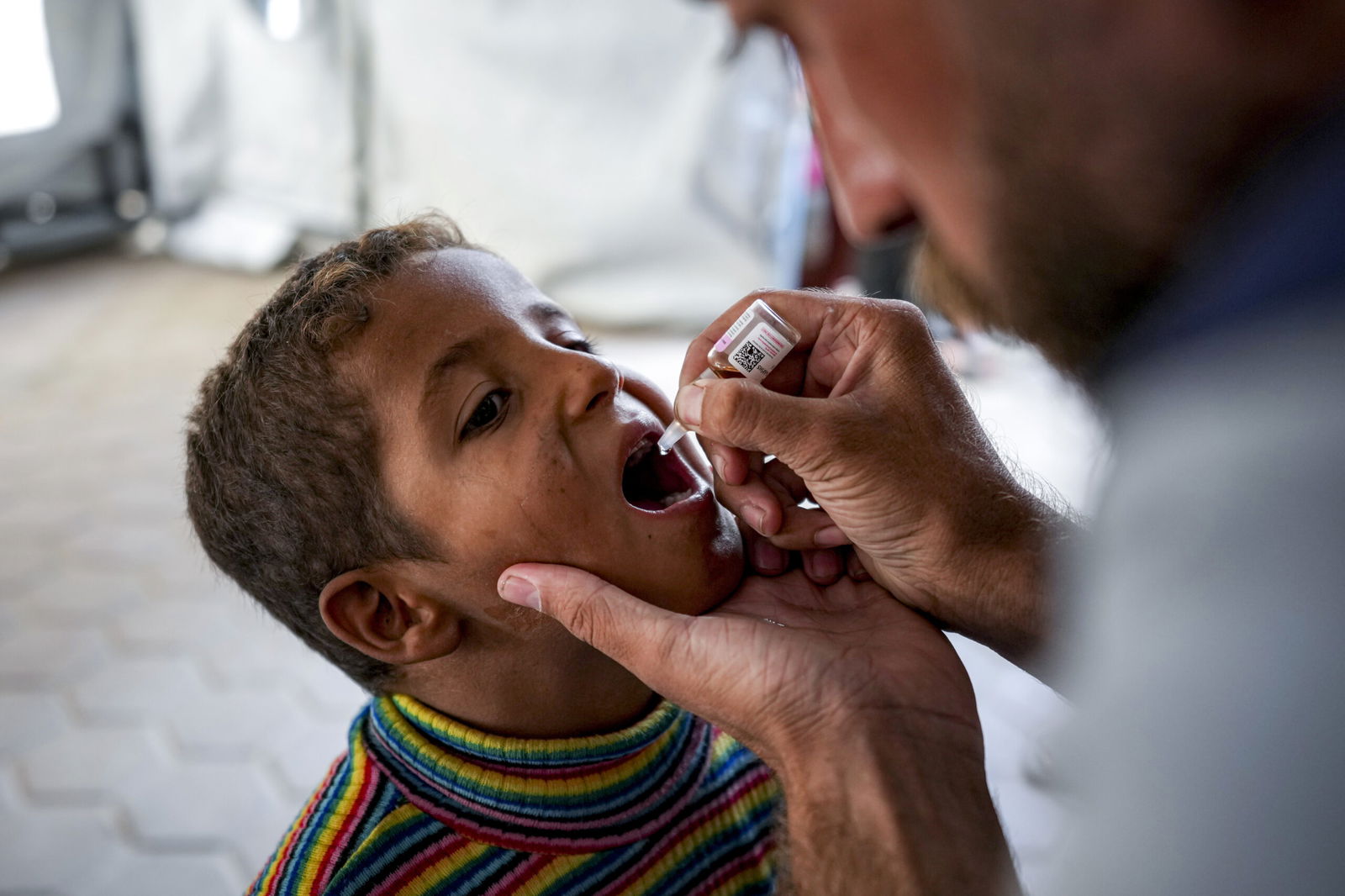Around the World briefs

By Associated Press
Large-scale polio vaccinations
begin in war-ravaged Gaza
after first case in 25 years
DEIR AL-BALAH, Gaza Strip | Palestinian health authorities and United Nations agencies on Sunday began a large-scale campaign of vaccinations against polio in the Gaza Strip, hoping to prevent an outbreak in the territory that has been ravaged by the Israel-Hamas war.
Authorities plan to vaccinate children in central Gaza until Wednesday before moving on to the more devastated northern and southern parts of the strip. The campaign began with a small number of vaccinations on Saturday and aims to reach about 640,000 children.
Gaza’s Health Ministry said more than 72,600 children received vaccines Sunday.
The World Health Organization has said Israel agreed to limited pauses in the fighting to facilitate the campaign. There were initial reports of Israeli strikes in central Gaza early Sunday, but it was not immediately known if anyone was killed or wounded. The pause ended Sunday afternoon, according to a schedule released by Israel.
Israel has said the vaccination program will continue through Sept. 9 and last eight hours a day.
Gaza recently reported its first polio case in 25 years — a 10-month-old boy, now paralyzed in a leg. The World Health Organization says the presence of a paralysis case indicates there could be hundreds more who have been infected but aren’t showing symptoms.
Most people who have polio do not experience symptoms, and those who do usually recover in a week or so. But there is no cure, and when polio causes paralysis, it is usually permanent. If the paralysis affects breathing muscles, the disease can be fatal.
The vaccination campaign faces challenges, from ongoing fighting to devastated roads and hospitals shut down by the war. Around 90% of Gaza’s population of 2.3 million people have been displaced within the besieged territory, with hundreds of thousands crammed into squalid tent camps.
Health officials have expressed alarm about disease outbreaks as uncollected garbage has piled up and the bombing of critical infrastructure has sent putrid water flowing through the streets. Polio is spread through fecal matter. Widespread hunger has left people even more vulnerable to illness.
“We escaped death with our children, and fled from place to place for the sake of our children, and now we have these diseases,” said Wafaa Obaid, who brought her three children to the Al-Aqsa Martyrs Hospital in Deir al-Balah to get the vaccinations.
Ammar Ammar, a spokesperson for the U.N. children’s agency, said it hopes both parties adhere to a temporary truce in designated areas to enable families to reach health facilities.
“This is a first step,” he told The Associated Press. “But there is no alternative to a cease-fire because it’s not only polio that threatens children in Gaza, but also other factors, including malnutrition and the inhuman conditions they are living in.”
The vaccinations will be administered at roughly 160 sites across the territory, including medical centers and schools. Children under 10 will receive two drops of oral polio vaccine in two rounds, the second to be administered four weeks after the first.
Israel allowed around 1.3 million doses to be brought into the territory last month, which are now being held in refrigerated storage in a warehouse in Deir al-Balah. Another shipment of 400,000 doses is set to be delivered to Gaza soon.
The polio virus that triggered this latest outbreak is a mutated virus from an oral polio vaccine. The oral polio vaccine contains weakened live virus and in very rare cases, that virus is shed by those who are vaccinated and can evolve into a new form capable of starting new epidemics.
The war in Gaza began when Hamas-led militants stormed into Israel on Oct. 7, killing some 1,200 people, mostly civilians, and abducting around 250 hostages. Around 100 remain in captivity, about a third of whom are believed to be dead.
Israel’s retaliatory offensive has killed over 40,000 Palestinians, according to the Health Ministry, which does not say whether those killed were fighters or civilians. The war has caused vast destruction across the territory, with entire neighborhoods wiped out and critical infrastructure heavily damaged.
The United States, Egypt and Qatar have spent months trying to broker a cease-fire and the release of the remaining hostages, but the talks have repeatedly stalled and a number of sticking points remain.
A lightning strike damages
Rome’s ancient Constantine Arch
ROME | Workers mounted a crane Wednesday to secure Rome’s Constantine Arch near the Colosseum after a lightning strike loosened fragments from the ancient structure.
A violent thunder and lightning storm that felled trees and flooded streets in the Italian capital damaged the honorary arch late Tuesday afternoon.
Fragments of white marble were gathered and secured by workers for the Colosseum Archeological Park as soon as the storm cleared, officials said. The extent of the damage was being evaluated.
“The recovery work by technicians was timely. Our workers arrived immediately after the lightning strike. All of the fragments were recovered and secured,’’ the park said in a statement.
Tourists visiting the site Wednesday found some stray fragments that they turned over to park workers out of concern they might have fallen from the arch.
“It is kind of surreal that we found pieces,” said Jana Renfro, a 69-year-old tourist from the U.S. state of Indiana, who said found the fragments about 12 feet (three meters) from the base of the monument.
The group’s tour guide, Serena Giuliani, praised them for turning over the found pieces, saying it showed “great sensitivity for Roman antiquities.”
The honorary arch, more than 20 meters (nearly 70 feet) in height, was erected in A.D. 315 to celebrate the victory of Emperor Constantine over Maxentius following the battle at Milvian Bridge.
Poland holds a state burial for
more than 700 victims of Nazi Germany’s World War II massacres
WARSAW, Poland | Poland held a state burial Monday for more than 700 victims of Nazi Germany’s World War II mass executions, whose remains were recently uncovered in the so-called Valley of Death in the country’s north, decades after their deaths.
The observances in the town of Chojnice began with a funeral Mass at the basilica, leading to an interment with military honors at a local cemetery of the victims of the Nazi crimes. The remains were contained in 188 small wooden coffins with ribbons in national white and red colors across them.
Joining the events were relatives of the victims, an aide to President Andrzej Duda, local authorities and top officials of the state National Remembrance Institute, which carried out and documented the exhumations.
“We want to give back memory, we want to give back dignity to the victims of the crimes in Chojnice,” presiding Bishop Ryszard Kasyna said.
Duda said in a message that the only reason the victims were killed by the Nazis was because they were Polish and said they would always be held in the national memory.
The remains of Polish civilians, including 218 asylum patients, were exhumed in 2021-2024 from a number of separate mass graves on the outskirts of Chojnice. Personal belongings and documents helped identify around 120 of the victims of an execution in early 1945. Among them were teachers, priests, police officers, forestry and postal workers, and landowners.
Historians have established that the Nazis, shortly after invading Poland on Sept. 1, 1939, executed some of the civilians, in a drive to subdue the nation. The remains of another 500 victims are from the January 1945 execution, when the Germans were fleeing the area. Bullets and shells from handguns used by German forces were found in the graves.
Experts will continue to comb the area for more mass graves of the so-called Pomerania Crime.
Poland lost 6 million citizens, or a sixth of its population, of which 3 million were Jewish, in the war. The country also suffered huge losses to its infrastructure, industry and agriculture.
Thousands of Turks protest controversial law to remove stray dogs
ISTANBUL | Thousands of demonstrators gathered in Istanbul on Sunday to protest recent legislation that critics say is leading to the killing of stray dogs across Turkey.
Last month, legislators approved the new law aimed at removing millions of stray dogs from Turkish streets citing safety concerns. Animal-lovers fear it will lead to widespread culling or dogs ending up in disease-ridden and overcrowded shelters.
President Recep Tayyip Erdogan said the law was necessary to deal with the country’s “stray dog problem.”
Sunday’s protesters called for the law to be repealed, brandishing posters reading ‘shelters are death camps’ and ‘withdraw the bloody law.’
“We want this law to be withdrawn immediately,” protester Hasan Kizilyatak, 64, told The Associated Press. “They (stray dogs) are living beings, just like us. We are here because we are against them being annihilated.”
Ayten Arslan, 55, who said she supports Erdogan, also showed up to protest.
“Just like we stood beside our president on July 15 (2016) when there was a coup attempt, we are here for the stray animals,” she told the AP. “I say as an AK Party supporter, this law, is a bloody law.”
The main opposition Republican People’s Party moved to repeal the law in the Constitutional Court less than two weeks after it passed.
The government estimates that around 4 million stray dogs roam Turkey’s streets and rural areas. Although most are harmless, several people, including children, have been attacked.
A report released by the Safe Streets and Defense of the Right to Life Association, an organization campaigning for the removal of all stray dogs from the streets, says that 65 people have died in street dog attacks since 2022.
The new legislation requires municipalities to collect stray dogs and house them in shelters to be vaccinated, neutered and spayed before making them available for adoption. Dogs that are in pain, terminally ill or pose a health risk to humans will be euthanized. The initial draft bill included cats, but that article was changed after a public outcry.
However, many question where cash-strapped municipalities would find the money to build the necessary extra shelters required.
Animal rights activists worry that some municipalities might kill dogs on the pretext that they are ill rather than allocate resources to shelter them.
Videos showing dead cats and dogs buried in ditches have been circulating on social media recently. Animal rights activists say the animals were indiscriminately killed after the passage of the law.
—From AP reports


